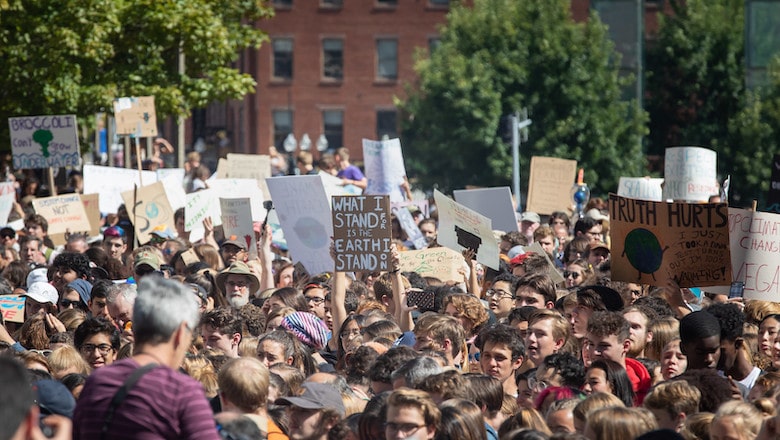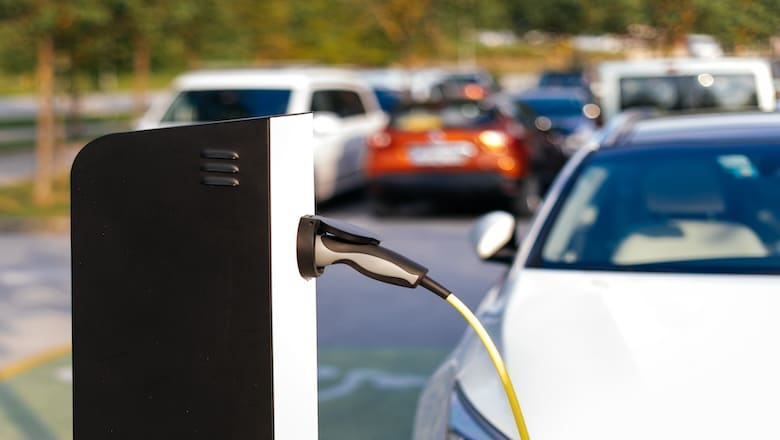System change, not climate change: how K-12 schools are addressing sustainability for a generation of climate activists
Nearly 4 million people participated in worldwide climate strikes last September, in solidarity with 17-year-old Swedish activist Greta Thunberg, who made the trek to New York City across the Atlantic by boat. It’s no coincidence that teenagers are some of the most engaged climate activists today. How are their schools rising to the challenge?

Photo ©2019 Ben Carmichael, Concord Academy
At the climate strike on September 20, 2019, a handful of us from GreenerU joined the several thousands of people that flooded Boston’s City Hall Plaza demanding climate justice. A large crowd of both young and old faces joined together by youth-directed resistance songs, speakers, and marched with thought-provoking signs, demonstrating their commitment to climate action.
The ongoing Friday for Future protests, along with the the Global Climate Strike—also known as the Youth Climate Strike—showed the world that our house is on fire and that the global youth aren’t going to sit back and watch us not address it. They’re standing up for science, taking action, and holding leaders accountable for their (in)actions.
For many of these young people, the awareness of stewardship and willingness to take action began in their more immediate communities: at their schools. Here’s how some schools have already taken steps toward addressing climate change today and working towards a more sustainable future.
Strategic plans
The development of a strategic plan is one of the most comprehensive ways to orient and align an institution’s students, faculty, staff, community, and parents in a unified direction: working together to achieve sustainability goals for their school and beyond.
An effective sustainability planning process should be inclusive and realistic, celebrating and building on the commitment and on-going work already happening within the community. It will solicit input from the community with important insight from the key-stakeholders. A successful sustainability planning process not only draws from best practices in sustainable operations, but digs more deeply into setting goals around greenhouse gas emissions through renovations, new construction, and energy supply, while uniting the whole community in a sustainable vision that aligns with the school’s educational mission.
Some elementary and high schools have organized their on-going sustainability efforts and created concrete goals by developing sustainability strategic plans:
- In 2013, Deerfield Academy in Deerfield, Massachusetts, launched a Sustainability Action Plan. Complementing their newly adopted sustainability mission statement, the plan is comprehensive documentation of past progress and future success to achieve regarding whole campus sustainability, laying out goals and recommendations for the school in areas ranging from finance and operations to building and construction to energy and climate.
- Eagle Rock Elementary School, a public school in Los Angeles, was honored by the U.S. Department of Education’s Green Ribbon School program this year for their adoption of an environmental manifesto. The ERE Environmental Manifesto is a whole-school framework to support the school in integrating sustainability into every function of the school. The school has adopted nine literacy requirements for its students to address the interconnectivity of our earth.
- Last year, Concord Academy joined the list of sustainability leaders in publishing their own sustainability plan. GreenerU worked with Concord Academy to develop a cohesive plan that pulled all of their current sustainability efforts with the goals they want to reach in the future. Their work won the attention of both Wicked Local and the Boston Globe! You can read more about their process in our blog post.
- St. Mark’s School in Southborough, Massachusetts, also developed a sustainability strategic plan in 2017, which encompasses sustainability in an impressive ten domains.
- Phillips Academy in Andover, Mass., has an operational climate action plan, published in 2019, which aims for a 30% reduction in emissions from 2005 by 2030, among other goals.
Carbon neutrality goals
Setting a carbon neutrality date is a great approach to galvanizing a school community around specific sustainability goals. To achieve carbon neutrality, a school typically needs to develop a climate action plan that includes baseline emissions data, investments in efficient electricity-powered mechanical equipment such as ground- or air-source heat pumps, and transitioning power sources to renewables.
- Public schools are also weighing the costs and benefits of energy-efficient building operations. In Watertown, Massachusetts—one of the Commonwealth’s 240 Green Communities—the Watertown School Committee has made a commitment to zero-net energy buildings (ZNEB) for Hosmer and Cunniff Elementary Schools and is currently exploring the use of solar panels.
- The Berkeley Unified School District in California published a sustainability strategic plan with a carbon neutrality goal set for 2050.
- The Hotchkiss School in Lakeville, Connecticut, is among a small number of independent secondary schools in the nation to have set a carbon neutrality date. Using their 2020 carbon neutrality date as a guiding force, the school has been able to accomplish large sustainability updates including constructing multiple LEED gold certified buildings, maintaining and tracking their carbon emissions, and diversifying their campus energy sources.
Energy-efficient equipment
Achieving sustainability goals necessarily includes a reduction in energy use from fossil fuels. Building energy use accounts for a substantial portion of schools’ greenhouse gas emissions, and the bulk of those emissions comes from inefficient boilers and other HVAC equipment. GreenerU has worked with several schools on upgrading or improving equipment to engineer efficient solutions.
- Fessenden School in Newton, Massachusetts, has been pursuing long-range energy reduction strategies on the school’s campus. Following a utility infrastructure study, one of the main long-term solutions GreenerU recommended was converting the school’s steam heat system to hot water, a technology that reduces energy by 25%. Infrastructure upgrades at each building on the school’s 41-acre campus will involve a gradual shift to hot water when buildings are scheduled for a bundle of renovation projects, which enables the school to plan ahead. You can read more about Fessenden School here.
- The Acton-Boxborough School District in Massachusetts saw a 24% reduction in greenhouse gas emissions in just three years through both behavior-based and mechanical energy-efficiency measures, including lighting retrofits and upgrades to walk-in coolers.
- At Brooks School, in Andover, Massachusetts, finding energy-efficiency opportunities started at Luce Library, where a plan and financial incentives led to replacing an outdated chiller, pneumatic controls, and inefficient lighting. GreenerU went on to find energy savings opportunities at Brooks’s ice rink reconstruction and was an instrumental partner in the design and construction of a brand-new Center for the Arts. Read more about this here.
- Additional schools in New England that have partnered with GreenerU to invest in energy efficiency include Buckingham, Brown & Nichols, Phillips Academy, Kimball Union Academy, The Governors Academy, and Notre Dame Academy. Projects have included lighting upgrades, building controls, retrocommissioning, boiler renovations or replacements, HVAC system redesigns.
Dedicated sustainability staff
Goals and strategies are important components of sustainability planning and implementation, but how can schools accomplish them without a dedicated staff person to stay focused and drive momentum forward? Based on our experience with colleges and universities, paid sustainability staff is a major step toward ensuring that commitments toward sustainability and carbon neutrality stay on target regardless of tests, holidays, and summer vacation.
- In 2017, The Jefferson School in Georgetown, Delaware, hired their first environmental science coordinator to support the school’s educational programs and sustainability projects. Last year, U.S. Department of Education Green Ribbon Schools program noted this as one of their 2019 highlights (see page 39). With this employee, The Jefferson School has dedicated staff power responsible for the environmental education of the entire school community, including parents and upper administration.
- Boston Green Academy’s sustainability director established and oversees their Green Milestones program. The program extends through and builds upon the students’ experiences from grade 6 to grade 12 with the goal that each student will 1) establish a meaningful relationship with our community and earth, 2) grapple and engage with real-world sustainability issues, and 3) engage in leadership opportunities that promote sustainability.
- The San Francisco Unified School District has a team of sustainability staff, staring with the hire of its administrator in 2008. Among their sustainability goals are to reduce energy usage 50% by 2040; eliminate combustion of natural gas by 2040; and generate 100% of their own power needs by 2050.
One of the most compelling signs we saw at the climate strike said, “System Change, Not Climate Change.” This simple statement sums up how profound this movement truly is. It means that educational institutions must demonstrate system changes on their campuses and partner with students to lead the way.
Educational institutions have the responsibility to prepare students to tackle the world’s largest challenges. Students are already rising, asking for tools to make the largest impacts possible. It’s time for all schools to listen—and act.
As schools are thinking more about ways they can fight climate change—whether through student engagement, sustainability planning, or building operations—GreenerU has the expertise to help you navigate this terrain. Contact us to start a conversation today! And if your school is doing amazing work in sustainability and energy-efficiency, weigh in on Twitter or LinkedIn.



